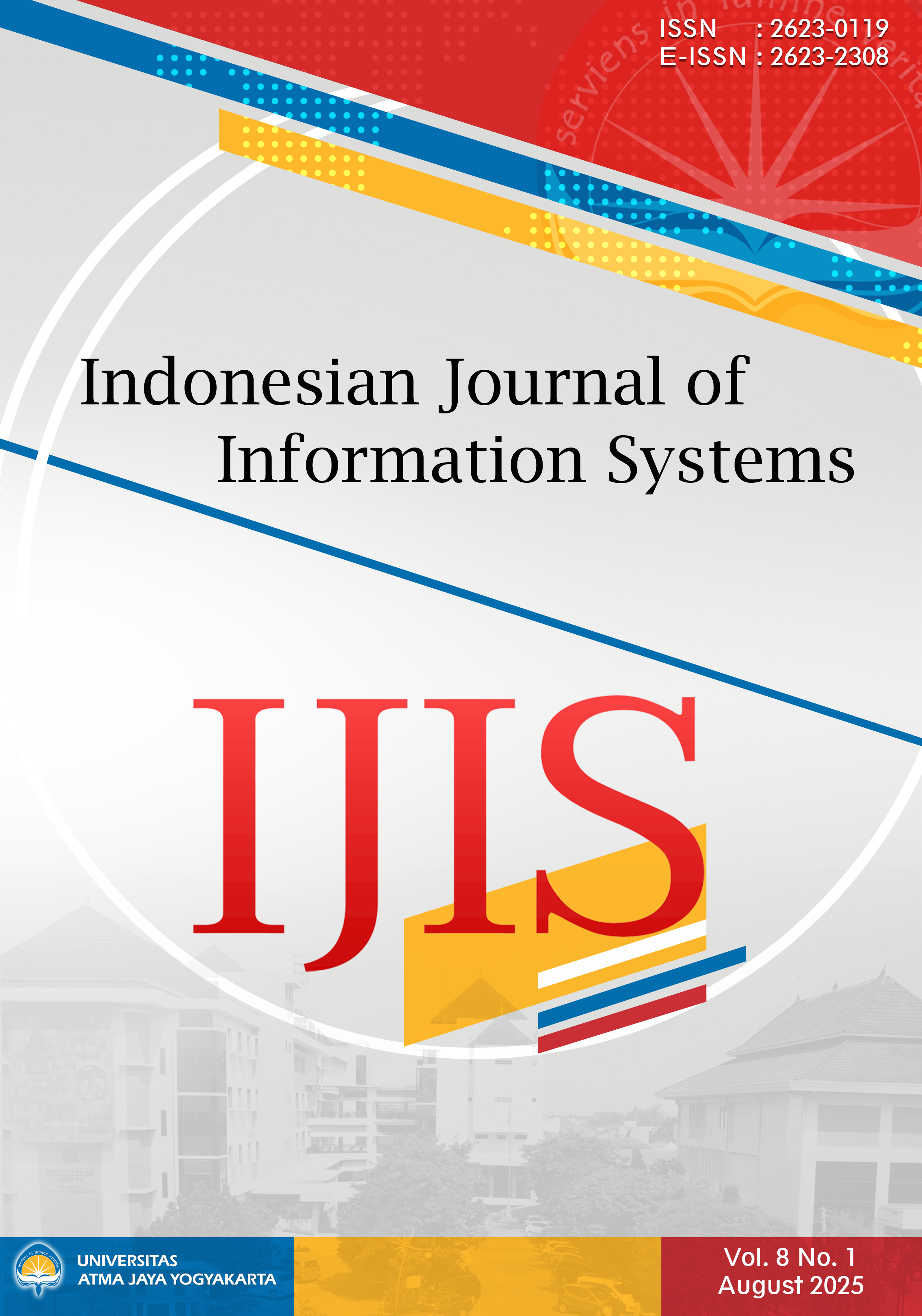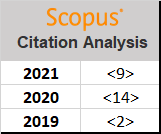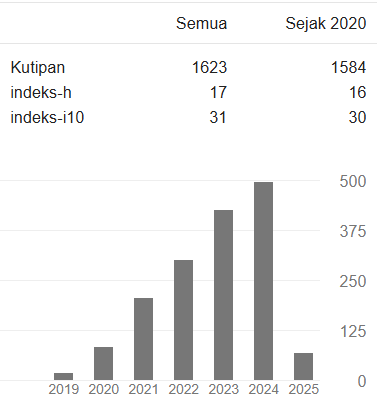Investigating the challenges, benefits, and applications of digital health in South Africa: A PRISMA process
DOI:
https://doi.org/10.24002/ijis.v8i1.11353Abstract
Digital health technologies have the ability to enhance the quality of healthcare. The usage of digital technologies (digital gadgets and their related apps, platforms, and websites) has led to numerous claims in public health and medical research about an impending breakthrough in the health sector, preventative medicine, and public health. Nevertheless, it is crucial to take a more cynical stance when evaluating the effects and consequences of digital health. Moreover, digital health adoption in developing and developed countries has disclosed several advantages, challenges, and applications. Thus, this study aimed to investigate the challenges, benefits, and applications of digital health in South Africa. The methodology utilized in this study was a qualitative systematic review through the PRISMA process and made use of documents such as accredited academic journals, articles, and books to gather data. This study used a sequential sampling method, and data were collected until saturation was reached. For purposes of data analysis, the study used thematic analysis to discover themes from the gathered data. The findings of this study revealed barriers that impede digital health adoption in South Africa. These barriers include technical, supportive policies, skilled manpower, and many more. Furthermore, work is needed to explore how the adoption of digital health technologies will affect the work of individuals. It is recommended that end users be trained on how to use digital health systems and many other things.
References
[1] B. D. Osunyomi and S. S. Grobbelaar, "Integrating eHealth in HIV/AIDS intervention programmes in South Africa," South African Journal of Information Management, vol. 17, no. 1, pp. 1-10, 2015.
[2] L. S. Busagala and G. C. Kawono, "Underlying challenges of e-health adoption in Tanzania," International Journal of Information and Communication Technology Research, vol. 3, no. 1, pp. 34-41, 2013.
[3] A. Nielsen, "eHealth activities and hearings aids–A systematic review," in Proceedings of Brifish Academy of Audiology 13th Annual Conference, 2016, pp. 10-11.
[4] K. A. Stroetmann, J. Artmann, and V. Stroetmann, "Developing national eHealth infrastructures–results and lessons from Europe," in AMIA Annual Symposium Proceedings, 2011, vol. 2011, p. 1347.
[5] S. T. Faloye, S. L. Ndlanzi, and N. Ajayi, "Factors affecting e-health adoption in South African public hospitals: a case of Edendale hospital," in 2021 IST-Africa Conference (IST-Africa), 2021: IEEE, pp. 1-11.
[6] W. H. O. World Health Organization, Atlas of EHealth Country Profiles: The Use of EHealth in Support of Universal Health Coverage: Based on the Findings of the Third Global Survery on EHealth 2015. World Health Organization, 2016.
[7] M. C. Katurura and L. Cilliers, "Electronic health record system in the public health care sector of South Africa: A systematic literature review," African journal of primary health care & family medicine, vol. 10, no. 1, pp. 1-8, 2018.
[8] S. S. Furusa and A. Coleman, "Factors influencing e-health implementation by medical doctors in public hospitals in Zimbabwe," South African Journal of Information Management, vol. 20, no. 1, pp. 1-9, 2018.
[9] I. A. Mobosi, P. O. Okonta, and C. A. Ameh, "Socio economic determinants of demand for healthcare utilization in Nsukka Local Government Area of Enugu State Nigeria," African Social Science and Humanities Journal, vol. 3, no. 3, pp. 22-35, 2022.
[10] M. M. Uzomah, "Mankind’s future in the providence of bio-science: A nostalgia for the eugenic teleology of genetics and genomics," Journal of Emerging Technologies, vol. 2, no. 1, pp. 18-29, 2022.
[11] S. Hellberg and P. Johansson, "eHealth strategies and platforms–The issue of health equity in Sweden," Health Policy and Technology, vol. 6, no. 1, pp. 26-32, 2017.
[12] G. Mburu and G. George, "Determining the efficacy of national strategies aimed at addressing the challenges facing health personnel working in rural areas in KwaZulu-Natal, South Africa," African Journal of Primary Health Care and Family Medicine, vol. 9, no. 1, pp. 1-8, 2017.
[13] E. Mbunge, J. Batani, G. Gaobotse, and B. Muchemwa, "Virtual healthcare services and digital health technologies deployed during coronavirus disease 2019 (COVID-19) pandemic in South Africa: a systematic review," Global health journal, vol. 6, no. 2, pp. 102-113, 2022.
[14] P. Sylva, R. J. Brown, and J. Batchelor, "A rapid review of digital health strategies and policies in response to COVID-19 pandemic," Sri Lanka Journal of Bio-Medical Informatics, vol. 11, no. 1, 2020.
[15] WHO, "Global strategy on digital health 2020-2025," 2021.
[16] A. NDoHS, "National digital health strategy for South Africa 2019–2024," Pretoria, South Africa, 2019.
[17] T. Thulare, M. E. Herselman, and A. Botha, "Data integrity: Challenges in health information systems in South Africa," 2020.
[18] A. Manteghinejad and S. H. Javanmard, "Challenges and opportunities of digital health in a post-COVID19 world," Journal of Research in Medical Sciences, vol. 26, no. 1, p. 11, 2021.
[19] J. Z. I. Khan, "Expected challenges in e-health implementation: A case of rural hospitals in Pakistan," ed, 2019.
[20] A. South Africa. "Constitution of the Republic of South Africa No. 108 Of 1996 " https://www.gov.za/sites/default/files/images/a108-96.pdf (accessed.
[21] Y. Pillay and P. A. Motsoaledi, "Digital health in South Africa: innovating to improve health," vol. 3, ed: BMJ Specialist Journals, 2018, p. e000722.
[22] F. M. Najem, K. Dahleez, and Y. Ashour, "The Impact of Hospital Information System Quality on the Health Care Quality," Health Information Management Journal, vol. 38, no. 3, pp. 26-37, 2009.
[23] A. Trifu, E. Smîdu, D. O. Badea, E. Bulboacă, and V. Haralambie, "Applying the PRISMA method for obtaining systematic reviews of occupational safety issues in literature search," in MATEC Web of Conferences, 2022, vol. 354: EDP Sciences, p. 00052.
[24] B. Gundogan, A. Fowler, and R. Agha, "Assessing the compliance of systematic review articles published in leading dermatology journals with the PRISMA statement guidelines: A systematic review protocol," International Journal of Surgery Protocols, vol. 10, pp. 1-4, 2018.
[25] D. Moher et al., "Preferred reporting items for systematic review and meta-analysis protocols (PRISMA-P) 2015 statement," Systematic reviews, vol. 4, pp. 1-9, 2015.
[26] A. Liberati et al., "The PRISMA statement for reporting systematic reviews and meta-analyses of studies that evaluate healthcare interventions: explanation and elaboration," Bmj, vol. 339, 2009.
[27] N. Asiamah, H. Mensah, and E. F. Oteng-Abayie, "General, target, and accessible population: Demystifying the concepts for effective sampling," The qualitative report, vol. 22, no. 6, pp. 1607-1621, 2017.
[28] A. Casteel and N. L. Bridier, "Describing populations and samples in doctoral student research," International journal of doctoral studies, vol. 16, no. 1, 2021.
[29] M. N. Saunders, P. Lewis, A. Thornhill, and A. Bristow, "Understanding research philosophy and approaches to theory development," 2015.
[30] N. Showkat and H. Parveen, "Non-probability and probability sampling; 2017," ed, 2024.
[31] W. L. Neuman and L. Kreuger, "Social work research methods: Qualitative and quantitative approaches," (No Title), 2003.
[32] P. Bhardwaj, "Types of sampling in research," Journal of the Practice of Cardiovascular Sciences, vol. 5, no. 3, pp. 157-163, 2019.
[33] S. Thorne, Interpretive description: Qualitative research for applied practice. Routledge, 2016.
[34] H. K. Mohajan, "Qualitative research methodology in social sciences and related subjects," Journal of economic development, environment and people, vol. 7, no. 1, pp. 23-48, 2018.
[35] T. Azungah, "Qualitative research: deductive and inductive approaches to data analysis," Qualitative research journal, vol. 18, no. 4, pp. 383-400, 2018.
[36] J. Bell and S. Waters, Ebook: doing your research project: a guide for first-time researchers. McGraw-hill education (UK), 2018.
[37] L. S. Nowell, J. M. Norris, D. E. White, and N. J. Moules, "Thematic analysis: Striving to meet the trustworthiness criteria," International journal of qualitative methods, vol. 16, no. 1, p. 1609406917733847, 2017.
[38] M. Vaismoradi, H. Turunen, and T. Bondas, "Content analysis and thematic analysis: Implications for conducting a qualitative descriptive study," Nursing & health sciences, vol. 15, no. 3, pp. 398-405, 2013.
[39] K. M. Lukman, J. M. D. Quevedo, K. Kakinuma, Y. Uchiyama, and R. Kohsaka, "Indonesia Provincial Spatial Plans on mangroves in era of decentralization: Application of content analysis to 27 provinces and “blue carbon” as overlooked components," Journal of Forest Research, vol. 24, no. 6, pp. 341-348, 2019.
[40] N. K. Kayesa and M. Shung-King, "The role of document analysis in health policy analysis studies in low and middle-income countries: Lessons for HPA researchers from a qualitative systematic review," Health Policy OPEN, vol. 2, p. 100024, 2021.
[41] S. Renukappa, P. Mudiyi, S. Suresh, W. Abdalla, and C. Subbarao, "Evaluation of challenges for adoption of smart healthcare strategies," Smart health, vol. 26, p. 100330, 2022.
[42] N. Muinga et al., "Digital health Systems in Kenyan Public Hospitals: a mixed-methods survey," BMC medical informatics and decision making, vol. 20, pp. 1-14, 2020.
[43] A. Kesse-Tachi, A. E. Asmah, and E. Agbozo, "Factors influencing adoption of eHealth technologies in Ghana," Digital health, vol. 5, p. 2055207619871425, 2019.
[44] H. K. Namatovu and M. A. Magumba, "Barriers and Facilitators of eHealth Adoption Among Patients in Uganda–a Quantitative Study," in International Conference on e-Infrastructure and e-Services for Developing Countries, 2022: Springer, pp. 247-267.
[45] J. Razmak, C. H. Bélanger, and W. Farhan, "Development of a techno-humanist model for e-health adoption of innovative technology," International Journal of Medical Informatics, vol. 120, pp. 62-76, 2018.
[46] C. H. Tsai, A. Eghdam, N. Davoody, G. Wright, S. Flowerday, and S. Koch, "Effects of electronic health record implementation and barriers to adoption and use: a scoping review and qualitative analysis of the content," Life, vol. 10, no. 12, p. 327, 2020.
[47] S. Zajac, A. Woods, S. Tannenbaum, E. Salas, and C. L. Holladay, "Overcoming challenges to teamwork in healthcare: a team effectiveness framework and evidence-based guidance," Frontiers in Communication, vol. 6, p. 606445, 2021.
[48] S. R. Razu et al., "Challenges faced by healthcare professionals during the COVID-19 pandemic: a qualitative inquiry from Bangladesh," Frontiers in public health, vol. 9, p. 647315, 2021.
[49] M. M. Qureshi, A. Farooq, and M. M. Qureshi, "Current eHealth Challenges and recent trends in eHealth applications," arXiv preprint arXiv:2103.01756, 2021.
[50] M. Mitchell and L. Kan, "Digital technology and the future of health systems," Health Systems & Reform, vol. 5, no. 2, pp. 113-120, 2019.
[51] M. Botha, A. Botha, and M. Herselman, "The benefits and challenges of e-health applications: a content analysis of the South African context," in International Conference on Computer Science, Computer Engineering, and Social Media, 2014.
[52] D. M. Mugo and D. Nzuki, "Determinants of electronic health in developing countries," 2014.
[53] Y. Ronquillo, A. Meyers, and S. J. Korvek, "Digital health," 2017.
[54] N. L. Downing, D. W. Bates, and C. A. Longhurst, "Physician burnout in the electronic health record era: are we ignoring the real cause?," vol. 169, ed: American College of Physicians, 2018, pp. 50-51.
[55] O. Enaizan et al., "Electronic medical record systems: Decision support examination framework for individual, security and privacy concerns using multi-perspective analysis," Health and Technology, vol. 10, pp. 795-822, 2020.
[56] R. S. Evans, "Electronic health records: then, now, and in the future," Yearbook of medical informatics, vol. 25, no. S 01, pp. S48-S61, 2016.
[57] G. Fox and R. Connolly, "Mobile health technology adoption across generations: Narrowing the digital divide," Information Systems Journal, vol. 28, no. 6, pp. 995-1019, 2018.
[58] S. Safi, T. Thiessen, and K. J. Schmailzl, "Acceptance and resistance of new digital technologies in medicine: qualitative study," JMIR research protocols, vol. 7, no. 12, p. e11072, 2018.
[59] S. Rana, U. Tandon, and H. Kumar, "Understanding medical service quality, system quality and information quality of Tele-Health for sustainable development in the Indian context," Kybernetes, vol. 53, no. 10, pp. 3232-3253, 2024.
[60] A. Jeilani and A. Hussein, "Impact of digital health technologies adoption on healthcare workers’ performance and workload: perspective with DOI and TOE models," BMC Health Services Research, vol. 25, no. 1, p. 271, 2025.
[61] I. J. B. do Nascimento et al., "The global effect of digital health technologies on health workers’ competencies and health workplace: an umbrella review of systematic reviews and lexical-based and sentence-based meta-analysis," The Lancet Digital Health, vol. 5, no. 8, pp. e534-e544, 2023.
[62] H. Sikandar, A. F. Abbas, N. Khan, and M. I. Qureshi, "Digital technologies in healthcare: A systematic review and bibliometric analysis," 2022.
[63] S. Bowman, "Impact of electronic health record systems on information integrity: quality and safety implications," Perspectives in health information management, vol. 10, no. Fall, p. 1c, 2013.
[64] J. F. Vos, A. Boonstra, A. Kooistra, M. Seelen, and M. Van Offenbeek, "The influence of electronic health record use on collaboration among medical specialties," BMC health services research, vol. 20, pp. 1-11, 2020.
[65] C. S. Kruse, A. Stein, H. Thomas, and H. Kaur, "The use of electronic health records to support population health: a systematic review of the literature," Journal of medical systems, vol. 42, no. 11, p. 214, 2018.
[66] S. Johar and B. Patagundi, "Electronic Health Record System-Benefits And Challenges: A literature Review," International Journal of Research in Computer Application and Management, vol. 8, no. 2, pp. 1-3, 2018.
[67] V. Jagadeeswari, V. Subramaniyaswamy, R. t. a. Logesh, and V. Vijayakumar, "A study on medical Internet of Things and Big Data in personalized healthcare system," Health information science and systems, vol. 6, no. 1, p. 14, 2018.
[68] E. Kilsdonk, L. Peute, and M. W. Jaspers, "Factors influencing implementation success of guideline-based clinical decision support systems: a systematic review and gaps analysis," International journal of medical informatics, vol. 98, pp. 56-64, 2017.
[69] O. Olorunfemi, N. R. Osunde, O. M. Olorunfemi, and S. Adams, "Assessing nurses' attitudes toward the use of modern technology to care for patients at selected public and private hospitals, Benin-City, Nigeria, 2020," International Archives of Health Sciences, vol. 7, no. 3, pp. 143-148, 2020.
[70] K. Oyibo and J. Vassileva, "Investigation of the moderating effect of race-based personalization of behavior model design in fitness application," SN Applied Sciences, vol. 1, no. 9, p. 1118, 2019.
[71] F. Petersen, A. Brown, S. Pather, and W. D. Tucker, "Challenges for the adoption of ICT for diabetes self‐management in South Africa," The electronic journal of information systems in developing countries, vol. 86, no. 5, p. e12113, 2020.
[72] K.-Y. Kwahk, H. Ahn, and Y. U. Ryu, "Understanding mandatory IS use behavior: How outcome expectations affect conative IS use," International Journal of Information Management, vol. 38, no. 1, pp. 64-76, 2018.
[73] S. Mathur, S. Walter, I. Q. Grunwald, S. A. Helwig, M. Lesmeister, and K. Fassbender, "Improving prehospital stroke services in rural and underserved settings with mobile stroke units," Frontiers in neurology, vol. 10, p. 159, 2019.
[74] R. C. El-Kassem, A. S. Al-Kubaisi, A. Al-Hamadi, N. Al-Rakeb, and M. Al Naimi, "Path analytic investigation of the intention to adopt E-government services through mobile applications in Qatar (tam revisited)," 2020.
[75] S. Voutsidou, "E-health applications for smart and pervasive healthcare in Greece," What can we expect, 2021.
[76] M. Zhou, M. E. Herselman, and A. Coleman, "Investigating factors determining the use of the clinical care module by nurses through the UTAUT model," 2016.
Downloads
Published
How to Cite
Issue
Section
License

This work is licensed under a Creative Commons Attribution-ShareAlike 4.0 International License.
Indonesian Journal of Information Systems as journal publisher holds copyright of papers published in this journal. Authors transfer the copyright of their journal by filling Copyright Transfer Form and send it to Indonesian Journal of Information Systems.

Indonesian Journal of Information Systems is licensed under a Creative Commons Attribution-NonCommercial 4.0 International License.

















